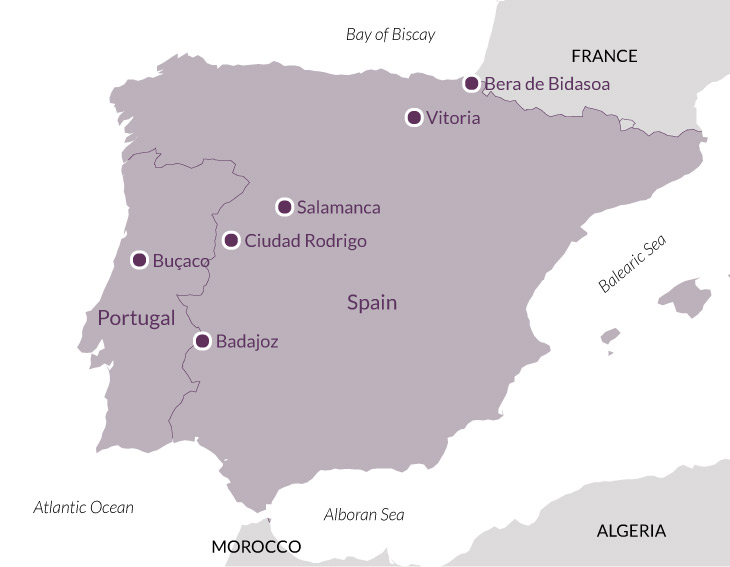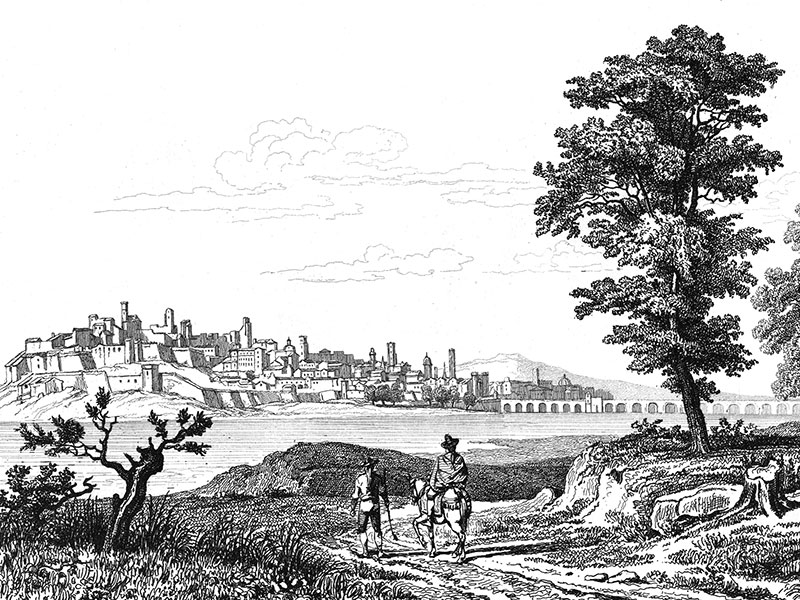Overview
Ascribing the eventual downfall of Napoleon to a single event is a dubious historical exercise, but here goes: his own decision in 1807, when he was at the height of his power, to plug the gap in the blockade which excluded British shipping from continental Europe.
The gap was Portugal, Great Britain’s long-time ally and trading partner. Marching French troops to Portugal through a hitherto submissive Spain provoked the Spanish people into bitter revolt, and Britain, seeing a relatively low-risk way of causing discomfort to France, committed troops to the Iberian Peninsula.
That the British would hang on in there for six years until they swept the French over the Pyrenees and defeated them in France itself was anticipated by no one – not Napoleon, because he was used to quick and decisive victories, nor the British, because there was fierce opposition to the war in Parliament and sustained criticism of the campaign in the country.
Nevertheless, the British under Wellington never lost a major battle, and, aided by Spanish guerillas, succeeded in tying down huge numbers of French troops and infecting Napoleon with his ‘Spanish ulcer’. Wellington developed a range of tactics which amounted to the elixir of success which had eluded Napoleon’s other opponents, and emerged as the only general of the Napoleonic Wars to rival Bonaparte himself for military genius. A master both of battlefield tactics and long-term strategy, he had an extraordinary capacity for logistical and administrative detail and for cool-headedness. And by chipping away for so long without significant reverse, he gave heart to the conquered and cowering capitals elsewhere in Europe. T
he War also has a significance for British history beyond its immediate achievements. The prestige of her armies had been at a low ebb after a century with few moments of glory and quite a lot of embarrassments. Indeed, England had not been considered internationally as a significant military power since the loss of French territories in the fifteenth century. The Peninsular War changed all that. Here at last was a saga of sustained success, albeit with some setbacks, and of great deeds of valour, albeit with episodes of barbarity and indiscipline. And, ultimately, there was victory, as has tended to be the case, by and large, ever since.
As a group, the battlefields of the Peninsula constitute the most dramatic and illuminating of the redcoat era. They are spread across an extraordinary variety of terrain and climate, from sun-baked plains to misty mountain passes. This tour will provide vistas of breath-taking beauty, and cities and villages which have scarcely changed in two hundred years.
Day 1
Fly at c. 11.55am from London Gatwick to Porto (TAP Portugal). Drive to the hotel in the forest of Buçaco, a former summer retreat for the Portuguese royal family. First of two nights in Buçaco.
Day 2
Buçaco. In the forest visit the museum commemorating the Battle of Buçaco, scene of Wellington’s great delaying action during his retreat to Torres Vedras. See also Craufurd’s Mill and the French view from Massena’s hill. There is an optional visit to Wellington’s command post or some free time to explore the grounds of the hotel. Overnight Buçaco.
Day 3
Obidos, Roliça, Badajoz (Spain). The long drive today heads south to Obidos, the site of Wellington’s HQ before the battle of Roliça, the British Army’s first battle in the Peninsula. From the battlements of the town we see the field of Roliça exactly as the Duke did before going to the memorial to the battle in the village through which the British Army advanced. Cross the border into Spain to the frontier town of Badajoz for the first of two nights.
Day 4
Badajoz, La Albuera. The ramparts of Badajoz, which provided formidable protection for the French, are still intact. The siege ended at tremendous cost with their storming by the British on the night of 6th April 1812, and the army went berserk for 72 hours afterwards. On 16th May 1811 at La Albuera, 15 miles away, was the bloodiest of the major battles; it remains one of the great unspoilt battlefields in the Peninsula. Overnight Badajoz.
Day 5
Alcántara, Ciudad Rodrigo. Head north via the Roman bridge in the village of Alcántara. Cross the Sierra de Gata, dividing line between Extremadura and Castilla-León, to Ciudad Rodrigo. Tour the defences, stormed on the night of 19th January 1812. Overnight Ciudad Rodrigo.
Day 6
Ciudad Rodrigo, Fuentes de Oñoro, Nave de Haver, Poço Velho (Portugal). At Ciudad Rodrigo visit the major breach through which the Light Division attacked, the memorial to Black Bob Crawford (who died leading them) and then the site of the storming by the 3rd Division. Moving through the still battle-scarred town, study the diversionary attack on the opposite walls before the site of the surrender of the French commander. On the border with Portugal lies Fuentes de Oñoro, site of a hard-fought battle in early May 1811 and Nave de Haver and Poço Velho, two of the crucial parts of the initial stages of the battle. Back in Spain, cross the meseta to the city of Salamanca for the first of three nights.
Day 7
Salamanca. The Battle of Salamanca, 22 July 1812, was one of Wellington’s greatest victories. Tour the battlefield in depth, beginning at Miranda de Azán before climbing the Greater Arapil for a grandstand view of the site. In the afternoon visit Garcihernández, scene of the great cavalry charge of the King’s German Legion. Overnight Salamanca.
Day 8
Salamanca. Morning visit of the walls and remains of the three convents that were hastily converted to fortresses around San Vicente in order to protect the main bridge into the town and which had to be taken by storm. Free afternoon in Salamanca, a city architecturally endowed beyond all proportion to its size with two cathedrals, Spain’s oldest university, the most beautiful and animated main square on the Peninsula and countless convents, monasteries and palaces. Overnight Salamanca.
Day 9
Burgos, Vitoria. Drive to Burgos, early capital of Castile, with one of Spain’s finest Gothic cathedrals. Visit the remains of the hill-top castle, scene of Wellington’s only major setback in the Peninsula and then the outlying Hornwork which had to be taken before the main defences could be attacked. Overnight Vitoria.
Day 10
Vitoria. Tactically perhaps Wellington’s most brilliant battle, the Battle of Vitoria on 21 June 1813 effectively decided the outcome of the war. It also brought about, for the first time, Napoleon’s acknowledgement that the Allies had a general who was as good as any he could muster, and news of the victory precipitated the end of the truce in Central Europe and hence to the defeat of the French at Leipzig in October. Drive across the Basque Country and into the foothills of the Pyrenees. Stop at Cadoux’s bridge, scene of the desperate battle on 31st August 1813. First of three nights in Bera (Vera) de Bidasoa.
Day 11
Battle of the Nivelle and Pyrenees. A day dedicated to two battles. Travel by cogwheel railway to the top of the Rhune mountain and from here study the Battle of the Nivelle of 10th November 1813. At Bidart see the grave of the remarkable Lt Col Lloyd, Commanding Officer of 2/84th Regiment and the church at Arcangues which still bears the marks of its defence by the Light Division. Overnight Bera.
Day 12
Battle of the Nive. Drive to the site of Wellington’s crossing of the River Bidasoa on 7 October 1813 and the invasion of France. In the afternoon, study the last stages of the Battle of the Nive, 10–13 Dec. 1813, from the memorial at Mouguerre. See also the crucial bridge held so gallantly by the 3rd Buffs. Overnight Bera.
Day 13
San Sebastián. San Sebastián was another triumphant siege for Wellington’s men, but its aftermath was almost as disgraceful as that at Badajoz. The castle ramparts give an unparalleled view of the assaults with an excellent museum that shows much of the technical site of siege work. Drive to Bilbao for the flight to London Gatwick (Vueling), arriving c. 7.20pm.
Price, per person
Two sharing: £3,370 or £3,250 without flights. Suite supplement in Bera: £50 (per person based on 2 sharing). Single occupancy: £3,790 or £3,670 without flights.
Included
Flights (economy class) with TAP Portugal and Vueling (aircraft: Airbus A319 & A320); travel by private coach; hotel accommodation as described below; breakfasts, 2 lunches (including one picnic) and 9 dinners with wine, soft drinks, water and coffee; all admissions; all tips; all state and airport taxes; the services of the lecturer and tour manager.
Accommodation
Buçaco Palace, Buçaco: comparable to a 4-star, one of the great hotels of Portugal in a turn-of-the-century palace. Hotel Zurbarán, Badajoz: a functional 4-star in the centre of town with adequately comfortable rooms. Parador Ciudad Rodrigo, Ciudad Rodrigo: 4-star parador installed in a 14th-century castle with splendid public areas. NH Palacio de Castellanos, Salamanca: attractive 4-star hotel in a converted palace, close to the Cathedrals and other key sites. Hotel Silken Ciudad de Vitoria, Vitoria: a stylish 4-star hotel, a short walk from the centre of town. Hotel Churrut, Bera de Bidasoa: a 3-star hotel installed in an 18th-century military building; family owned and managed with 17 spacious rooms; well-furnished and comfortable sitting areas. The majority of included dinners are in the hotels. Single rooms are doubles for sole use throughout.
How strenuous?
This is a long tour involving six hotels and a lot of walking, some of it across uneven, countryside terrain and uphill. Fitness and sure-footedness are essential. There is also a fair amount of standing around on site. Transfer days involve lengthy coach journeys. Average distance by coach per day: c. 100 miles.
Are you fit enough to join the tour?
Group size
Between 10 and 22 participants.
Travel advice
Before booking, please refer to the FCDO website to ensure you are happy with the travel advice for the destination(s) you are visiting.

